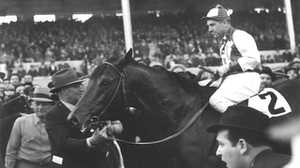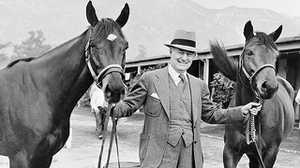Racing and Radio Broadcasts
In the late 1930s, record crowds gathered wherever Seabiscuit ran. Many of his fans, though, too far away to see his exploits, listened to them on the radio, the revolutionary technology that came of age just as Seabiscuit did. Radio extended the horse’s fame in ways that wouldn’t have been possible even a decade earlier.

A Growing Audience
In the 1920s, only the affluent could buy radios; each one cost $120 or more. If you could afford it, you usually had to assemble it yourself. In 1921, the radio station WJZ of Newark, New Jersey was the first to broadcast a baseball World Series, but it wasn’t until the 1930s that most sports fans began to turn regularly to radio to hear contests live. After the Great Depression descended, factories churned out radio consoles and tabletop versions for as little as $5, and automobile manufacturers added them to their cars. The market for radios grew even larger when President Franklin Rosevelt passed legislation in 1936 to bring electricity to the nation’s farmlands, where one quarter of the population lived.
The New Hearth
Floor model radios became the new hearths in homes, and family members crowned them with cherished family photos. Any form of entertainment that could convey itself with sound alone used the medium to reach its audience. Families gathered around their radios to laugh at comedian Jack Benny or ventriloquist’s dummy Charlie McCarthy — or to try to solve a murder mystery. Daytime radio became dominated by soap operas. After school, boys and girls would listen to radio dramas such as “Jack Armstrong, the All-American Boy” or “Captain Midnight.” On October 31, 1938, Orson Welles spooked many listeners when he broadcast the radio drama “The War of the Worlds,” which reported that Martians had landed in New Jersey. A year later, 20 million listeners tuned in regularly to “The Lone Ranger.”
Millions of Listeners
In 1935, when Seabiscuit started racing, two-thirds of the nation’s homes had a radio. A few years later, at the height of the horse’s popularity, 90 percent of homes had one. Newspapers reached thousands, movies reached even more, but radio was different because millions of people all tuned in to the same live event at the same time all over the nation. One of the most radio-friendly events in the world of sports was the horse race: unpredictable, dramatic, and over in only a few minutes.
A Miraculous Invention
“Radio was, in the period when Seabiscuit was around, the center of a family’s existence,” says author Gene Smith. “The radio was practically the size of today’s refrigerator. It was burnished with terrific wood, walnut or mahogany, and the dialing of it required great finesse, which was the province of the father of the house. There was one radio per house, no matter whose house it was, and people saved for their radio, and it was delivered, and it was a miraculous thing, a miraculous, wonderful invention. It could bring the sound of Jack Dempsey beating [Georges] Carpentier to a Montana rancher. It could bring Franklin D. Roosevelt saying 'my friends’ to Louisiana plantations, and it could bring this stubby, little, blocky, unattractive-looking horse Seabiscuit all over the United States.”
An American Ritual
At the peak of his fame in the late 1930s, Seabiscuit ran about once a week during the racing season. It became an American ritual for families and friends to gather around the radio and listen to him run. “Someone told me you could walk down a street, and… during one of Seabiscuit’s races, you’d hear every radio on the block, tuned into it, people cheering,” says author Laura Hillenbrand. “That has a lot to do with why he became such a huge celebrity in America.”







